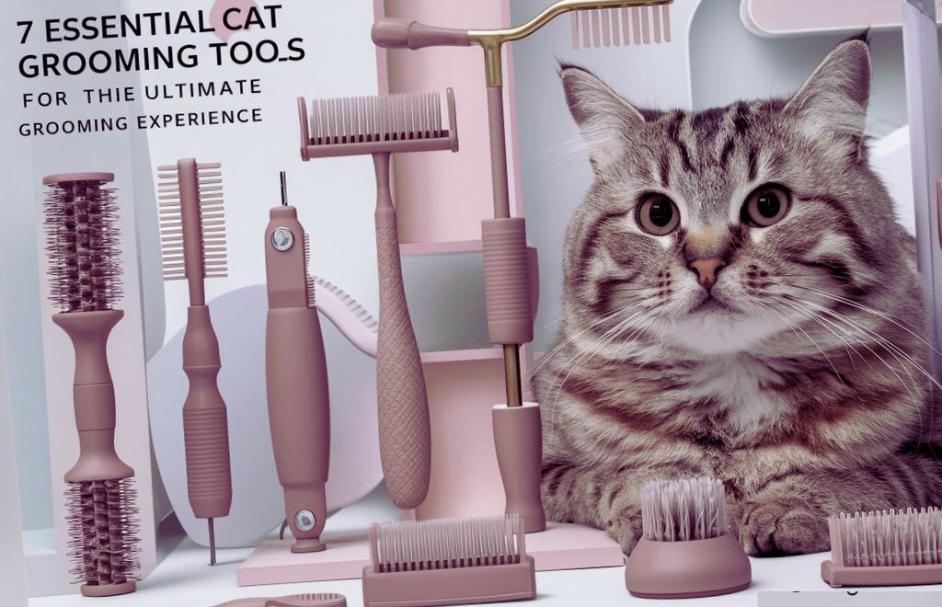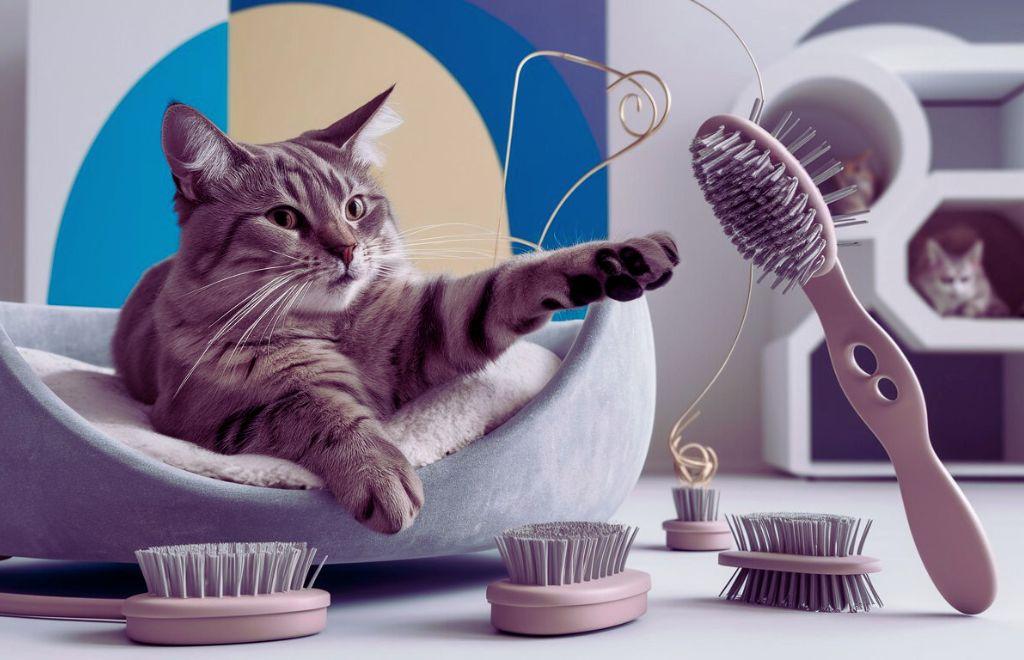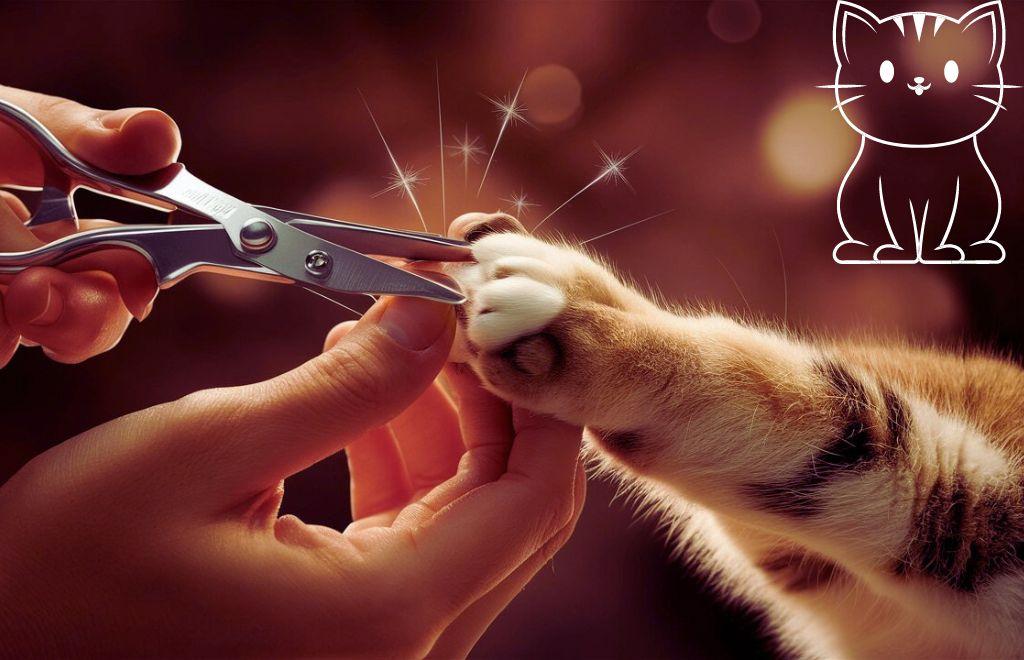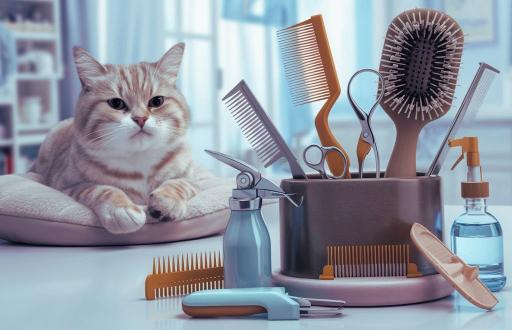For the feline fanatic, a cat’s coat is a window into its well-being. A lustrous, tangle-free mane speaks volumes about a content kitty, while a matted mess can signal underlying health issues or simply a grooming routine gone awry. Yet, the prospect of wrangling your whiskered friend for a grooming session can be daunting. Fear not, fellow cat fanciers! This article unveils a treasure trove of 7 cat grooming tools that will not only make the process purr-fectly pleasant but also leave your feline friend’s fur looking fabulous.
The Necessity of Cat Grooming Tools
While some might scoff at the notion of needing specialized tools to groom a cat, those seasoned in the ways of feline finesse understand the truth: cat grooming tools are not mere frivolous accessories, but an essential arsenal in the battle against furballs, matting, and discomfort.

Beyond the Aesthetic: Unveiling the Health Benefits
Sure, a well-groomed cat with a sleek, lustrous coat is a sight to behold. But the benefits of cat grooming extend far beyond mere aesthetics. Here’s how these specialized tools become instruments of feline well-being:
- Mat Masters: For longhaired breeds, mats are the enemy. Not only do they trap dirt and debris, but they can also be incredibly uncomfortable and even painful for your cat. Tools like undercoat rakes and de-shedding combs effectively remove loose fur before it tangles, preventing the formation of these dreaded mats.
- Skin Saviors: Regular brushing stimulates blood circulation, promoting healthy skin and hair growth. Additionally, these tools remove dead skin cells that can irritate your cat’s delicate skin.
- Hairball Heroes: Excessive shedding can lead to hairballs, causing digestive discomfort for your feline friend. Grooming tools like slicker brushes help remove loose fur before it gets ingested, significantly reducing the frequency and severity of hairballs.
- Early Detection: The act of grooming provides a valuable opportunity to inspect your cat’s skin for abnormalities like fleas, ticks, or signs of potential health problems. Early detection is crucial for ensuring your cat receives prompt veterinary care if needed.
Tailored Tools for Tailored Needs:
Not all cats are created equal, and their grooming needs differ. A short haired cat might require a simple bristle brush for occasional brushing, while a longhaired beauty might necessitate a multi-tool approach involving undercoat rakes, slicker brushes, and even grooming gloves for sensitive souls.
Investing in the right tools ensures a more efficient and comfortable grooming experience for both you and your cat. Think of it as customizing your approach to cater to your feline friend’s specific fur type and temperament.
A Bonding Ritual, Not a Chore:
Grooming doesn’t have to be a stressful ordeal. By using the right tools and techniques, you can transform it into a bonding ritual. A gentle touch, calming words, and perhaps a strategically placed treat can turn grooming time into a purr-fect opportunity to strengthen the connection between you and your cherished companion.
So, the next time you consider cat grooming tools as frivolous extras, remember, they are the key to unlocking a healthier, happier, and undeniably more majestic feline friend.
7 Cat Grooming Tools
Here’s a comprehensive arsenal of 7 cat grooming tools to transform your scruffy house lion into a purrfectly groomed royalty:
1. The Humble Brush: A Master of Many Coats
The cornerstone of any cat grooming arsenal is a good brush. But with an overwhelming array of options, choosing the right one can feel like deciphering a hieroglyphic. For short-haired breeds, a bristle brush is your best bet. Its firm bristles detangle loose fur and massage the skin, promoting healthy circulation and a gleaming coat. Long-haired cats, on the other hand, require a double-duty approach. Start with an undercoat rake to gently remove excess fur and prevent matting, then follow up with a slicker brush to distribute natural oils and create a sleek, shiny finish.

2. Deshedding Tools: Unleashing Your Inner Furminator
Shedding is a natural part of a cat’s life, but it can wreak havoc on your furniture and wardrobe. Enter the deshedding tool, a modern marvel designed to target and remove loose fur before it has a chance to become a feline tumbleweed. These tools come in various forms, from furminator-style brushes with specially designed teeth to grooming gloves that mimic the sensation of petting. Experiment with different options to find what works best for your cat’s coat type and tolerance.
3. The Slicker Brush: A Champion for Longhaired Beauties
For longhaired cats, the slicker brush becomes their knight in shining armor. This brush, with its fine, closely spaced metal teeth, glides effortlessly through fur, detangling knots and removing debris. The slicker brush also works wonders for distributing natural oils, leaving your cat’s coat luxuriously soft and tangle-free. Remember, a gentle touch is key when using a slicker brush, as overly aggressive strokes can irritate your cat’s skin.
4. The Dematting Comb: A Tamer of Tangled Tresses
Even with regular brushing, mats can occasionally form, especially in longhaired cats. Fret not, for the dematting comb is here to save the day! This specialized tool features widely spaced teeth that can navigate through matted fur without causing excessive pulling or discomfort to your feline friend. There are two main types of dematting combs: single-sided and double-sided. Single-sided combs have teeth on one side only, ideal for tackling light matting. Double-sided combs boast varying tooth lengths on either side, allowing you to address both minor and severe matting.
5. The Grooming Glove: A Multitasking Marvel
For cats who equate grooming with torture, the grooming glove is a game-changer. This ingenious tool resembles a mitten with soft, textured surfaces that collect loose fur as you gently pet your cat. The grooming glove not only removes fur but also massages your cat’s skin, stimulating circulation and promoting a healthy coat. Plus, many cats find the petting motion inherently calming, transforming grooming time into a bonding experience.
6. Cat Nail Clippers: Keeping Claws in Check
Scratching is a natural feline behavior, but untamed claws can wreak havoc on your furniture and decor. Regular nail trims are essential for maintaining paw health and preventing snags on carpets and upholstery. Cat nail clippers come in various styles, from guillotine clippers to scissor-style ones. Choose clippers appropriate for your cat’s paw size and your own comfort level. Remember, proper technique is crucial to avoid accidental nicks to the quick, the sensitive blood vessel inside the nail. If you’re unsure about clipping your cat’s nails yourself, enlist the help of a veterinarian or professional groomer.

7. Waterless Shampoo: A Bath Time Boon
Not all cats are water enthusiasts. For these feline aqua-phobes, waterless shampoos offer a purr-fect alternative. These shampoos come in various forms, including sprays, foams, and wipes. They are formulated to cleanse fur and remove dirt and dander without the stress of a traditional bath. Waterless shampoos are also a convenient way to keep your cat looking and smelling fresh between baths.
Conclusion
cat grooming tools are not mere luxury items, but essential allies in maintaining your feline friend’s health and happiness. By incorporating these tools into your routine, you can ensure your cat boasts a luxuriously healthy coat, free from matting and discomfort. More importantly, regular grooming sessions become a bonding ritual, strengthening the connection between you and your cherished companion. So, equip yourself with the right cat grooming tools, and embark on a journey to transform your scruffy house lion into the majestic creature they were always meant to be!
With the right tools and a little patience, transforming your cat’s coat from drab to fab can be a breeze. Remember, grooming is not just about aesthetics; it’s an essential part of feline health care. Regular brushing stimulates circulation, promotes healthy skin and coat growth, and helps detect any underlying health issues that might manifest as skin problems or excessive shedding. The process can also be a wonderful bonding experience, strengthening the connection between you and your furry companion.
Frequently Asked Questions for Cat Grooming Tools
How often should I groom my cat?
The frequency of grooming depends on your cat’s fur length. Short haired breeds typically need a good brush once a week, while longhaired cats might require daily brushing to prevent matting. Consider your cat’s individual needs as well. Senior cats or those with underlying health conditions might benefit from more frequent gentle grooming sessions.
What if my cat hates being groomed?
Start slow and make the experience positive. Offer treats or praise throughout the grooming session. Use gentle strokes and focus on areas your cat tolerates best. Short, frequent sessions are more effective than trying to wrestle your cat for a marathon grooming ordeal. There are also calming sprays or pheromone diffusers available that can help ease your cat’s anxiety during grooming time.
Is it okay to use human shampoo on my cat?
Absolutely not! Human shampoos have a different pH level than cat shampoo, which can irritate your cat’s skin and dry out their fur. Always use a cat-specific shampoo that is gentle and formulated for their delicate skin.
Can I use a brush designed for short haired cats on my long haired cat?
While it might not be ideal, in a pinch, a bristle brush can be used on a longhaired cat for a quick brush to remove loose fur. However, it won’t be as effective at detangling or removing undercoat fur. For longhaired cats, a double-duty approach with an undercoat rake and a slicker brush is recommended for optimal results.
By incorporating these tips and the aforementioned cat grooming tools into your routine, you can ensure your feline friend not only looks their best but also thrives with a healthy, luxurious coat.

